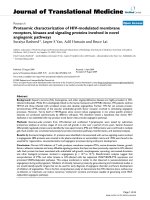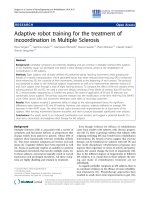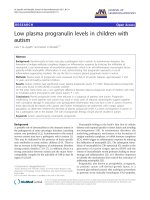Báo cáo hóa học: " Multidimensional characterization, Landau levels and Density of States in epitaxial graphene grown on SiC substrates" pdf
Bạn đang xem bản rút gọn của tài liệu. Xem và tải ngay bản đầy đủ của tài liệu tại đây (1.32 MB, 6 trang )
NANO EXPRESS Open Access
Multidimensional characterization, Landau levels
and Density of States in epitaxial graphene
grown on SiC substrates
Nicolas Camara
1
, Benoit Jouault
1*
, Bilal Jabakhanji
1
, Alessandra Caboni
2
, Antoine Tiberj
1
, Christophe Consejo
1
,
Philipe Godignon
2
, Jean Camassel
1
Abstract
Using high-temperature annealing conditions with a graphite cap covering the C-face of, both, on axis and 8° off -
axis 4H-SiC samples, large and homogeneous single epitaxial graphene layers have been grown. Raman
spectroscopy shows evidence of the almost free-standing character of these monolayer graphe ne sheets, which
was confirmed by magneto-transport measurements. On the best samples, we find a moderate p-type doping, a
high-carrier mobility and resolve the half-integer quantum Hall effect typical of high-quality graphene samples.
A rough estimation of the density of states is given from temperature measurements.
Introduction
It is now widely accepted that graphene-based devices
are promising candidates to complement silicon in the
future generations of high-frequency microelectronic
devices. To this end, the most favourable technique to
produce graphene for industrial scale applications seems
to be epitax ial graphene (EG) g rowth. This can be done
by chemical vapour deposition on a metal [1,2] or by
heating a SiC wafer up to the graphitisation temperature
[3-6]. In the first case, the disadvantage is the need to
transfer the graphene film on an insulating wafer. In the
second case, the SiC wafer plays the role of the insulat-
ing substrate without any need for furth er manipulation.
Of course, to be suitable for the microelectronics indus-
try, these EG layers must be continuous and homoge-
neous at the full wafer scale or, at least, on surfaces
large enough to process devices.
On the Si-face of 6H or 4H SiC substrates, graphitisa-
tion at high temperature in an Ar atmosphere close to
atmospheric pressure shows promising results for on-axis
substrates. In this way, single-layer epitaxial graphene
(SLEG) has already been grown at the full wafer scale
[7,8] but an open issue remains the 6√3 SiC surface
reconstruction which is a C-rich buffer monolayer on top
of the SiC substrate. The first “real” graphene layer on
top of this buffer layer is strained, not at all free-standing,
strongly coupled to the C-rich buffer, heavily n -t ype
doped, with a low-carrier mobility. On the contrary, on
the C-face of the same SiC substrates, there is no need of
a C-rich buffer l ayer at the interface before growing the
first graphene layer [9-12]. In this way, the mobility could
reach 30,000 cm
2
/V s in the work of Ref. [13].
For a long time, whatever the growth technique, the
uniformity and quality of the EG was not good enough
to find evidence of the so-called “half integer” quantum
Hall eff ect (QHE). However, recently, large SLEG areas
have been produced on the C-face of on-axis SiC sub-
strates and, on such monolayer graphene, the carriers
were holes with mo bility close to the one found in
mechanically exfoliated graphene films on SiO
2
/Si [ 14].
Consequently, the QHE could be demonstrated [15].
This shows clearly the advantage and quality of SLEG
grown on the on-axis C-face of a SiC wafer over the on-
axis Si-face. However, for further integration of gra-
phene with current SiC technology, 8° off-axis substrates
should be also considered since they constitute the stan-
dard in modern SiC industry [16].
In this work, we compare the results of graphene
growth on semi-insulating, on axis and and 8° off-axis,
4H-SiC substrates. The quality, unif ormity and size of
* Correspondence:
1
Laboratoire Charles Coulomb, UMR 5221 CNRS-UM2, Place Eugène Bataillon,
34095 Montpellier Cedex 5, France
Full list of author information is available at the end of the article
Camara et al. Nanoscale Research Letters 2011, 6:141
/>© 2011 Camara et al; licensee Springer. This is an Open Access article distri buted under the terms of the Creative Commons Attribution
License ( which permi ts unrestrict ed use, distribution, and reproduction in any medium,
provided the original work is properly cited.
the growth products will be compared using optical
micro scopy (OM), scanning electron microscopy (SEM),
atomic force microscopy (AFM) and micro-Raman spec-
troscopy (μR). Then, Hall effect measurements will be
done at different temperature in order to extract the
density of states in the epitaxial monolayers.
Graphene growth, microscopy and Raman studies
To produce SLEG, in both cases of on axis and 8° off-axis
SiC substrates, we used the recipes of Ref. [12]. On the
on-axis material, this produces l ong, self-ordered, gra-
phene ribbons which are typically 5 μmwideandseveral
100 μm long. This has been described at length in the
work of Ref. [16]. On the off-axis substrates, this resulted
also on SLEG islands but the morphology is c ompletely
different This is shown in Figure 1. Instead of narrow rib-
bons, after 30 min graphitisation at 1700°C, large SLEG
islands can be obtained which can reach 300 μmlong
and 50 μmwideforthebiggestones.SeeFigure1aand
1b. They can have a trapezoidal or triangular shape, see
Figure 1a-c and 1f and, usually, nucleate from a defect on
the surface. See Figure 1e and 1f. This may be either an
unintentional particle remaining on the surface, a crystal-
lographic defect such as a threading dislocation or a sim-
ple scratch made by a diamond tip. Whatever the origin,
the growth starts from one nucleating centre and
expands in a two-dimension carpet-like way. All resulting
triangles are then self-oriented, with the longest side
following the (11-20) plane direction.
In Figure 2a we show a typical AFM image of such a
SLEG islands. When zooming, wrinkles become clearly
visibleinFigure2andshowevidenceofthecontinuity
and s train-free character of the monolayers. Below the
graphene islands, the step-bunched areas of the SiC sur-
face are also clearly visible in both SEM and AFM pic-
tures. The corresponding terraces are typically 100 nm
wide and less than 2 nm high. A last evidence of the
fact that the first layer of graphene is not coupled with
the substrate and continuous despite the step-bunched
surface is the facility with which we can remove the
SLEG layer with an AFM tip. The result presented with
theAFMpictureofFigure2cdemonstratesthealmost
free-standing and continuous character of the grown
SLEG.
Figure 1 SEM i mages of a monolayer graphene islands grown on the C-face of an 8° off-axis 4H-SiC substrate. (a, b) Images of the
largest homogeneous SLEG islands, (c) early growth, (d) zoomed image with visible wrinkles, (e, f) example of starting nucleation point by a
surface defect with step bunching clearly visible in (f).
Camara et al. Nanoscale Research Letters 2011, 6:141
/>Page 2 of 6
Tens of similar monolayer islands grown on, both, on
axis and off-axis substrates were probed by Raman spec-
troscopy.Weusedthe514nmlaserlineofanAr-ion
laser for excitation and got very similar f eatures. At the
micrometer size, all spectra reveal that the islands are of
the same nature and very homogeneous. First, the
D-band, which usually indicates the presence of disorder
or edges defects, is very weak and the Ra man signature is
extremely close to the one found for exfoliated graphene
on SiO
2
/Si [11]. Second, the 2 D-band appears at low fre-
quency (2685 cm
-1
) which is strong evidence that there is
no strain at the layer to substrate interface (i.e. a lmost a
free-standing SLEG layer). Third, this 2D-band can be
fitted with a single Lorentzian shape with a FWHM of
30 cm
-1
[17]. Fourth, the ratio I
2D
/I
G
between the inte-
grated intensities of the 2D-band and the G-band is high,
which suggests weak residual doping in the order of 3 to
6×10
12
cm
-2
[18]. Altogether, these Raman and micro-
scopy measurements tend to demonstrate the almost
free-standing low-doped and continuous character of the
grown layers [12,19].
Electrical transport measurements
Gold alignment marks were used to select some SLEG
position by OM. Then, they were contacted by e -beam
lithography and subsequent deposition of a contact layer
made of Cr/Au in Hall bar configuration. A typical
example is shown in Figure 3.
Then transport measurements were done at low tem-
perature on the different samples, using a maximum
magnetic field of 13.5 T. The contact geometry allowed
simultaneous measurement of, both, the longitudinal
and transverse voltages with the current flowing
between two injection contacts at the flake extremities.
In both s eries of samples, from the sign of the Hall vol-
tage, we f ound that the carriers were holes (in agree-
ment with other results published on the C-face
[13,14]). The holes concentration ranged from 1 × 10
12
to 1 × 10
13
cm
-2
at low temperature, with a weak tem-
perature dependence.
For c arrier concentrations larger than 3 × 10
12
cm
-2
,
no QHE could be detected and only Shubnikov-de Haas
(SdH) oscillations were found. This is shown in Figure 4
for an off-axis sample and, as usual, the plot of the
inverse field at which the oscillations maxima occur ver-
sus t he Landau level index shows a clear linear depen-
dence going do wn to the origin. This is the usual
signature of the heavily doped graphene.
Figure 2 AFM images of continuous and almost free standing monolayer graphene islands grown on the C-face of an 8° off-axis
4H-SiC substrate. (a) at a large scale, the zoom in (b) showing the wrinkle and the step bunched character of the SiC surface below and (c) a
layer scratched by an AFM tip.
Figure 3 Optical microsc opy of a SLEG grown on 8° off -axis
semi-insulating SiC substrate. (a) before contact and (b) after
contacting in a Hall Bar configuration for Hall Effect measurement.
Camara et al. Nanoscale Research Letters 2011, 6:141
/>Page 3 of 6
For the low doped layers, the transverse resistance
exhibits now quantized Hall plateaus, clearly governed by
the sequence R
K
/4(N +1/2)inwhichR
K
= h/e
2
is the
Von Klitzing constant [20] and N = 0, 1, 2 As already
known, this peculiar sequence of resistance values is the
well-known quantum transport signature of the mono-
layer graphene Landau levels [14]. In Figure 4(b).we show
the longitudinal and Hall resistance values for such a
low-doped SLEG device with hole concentration n
s
=
1.2 × 10
12
cm
-2
and mobility μ ~5000 cm
2
/V s at T =
1.6 K. At B = 12 T, the longitudinal resistance c ancels
while the transverse resistance tends to 12.9 kΩ which is
the expected value for the N = 0 plateau (R
K
/2).
In Figure 5a, we present similar resistance measure-
ments obtained with a lower doped sample with a hole
concentration n
s
=8×10
11
cm
-2
and a mobility μ
~11,000 cm
2
/V s. The mobility i s high enough and the
concentration low enough to make the N = 0 and N =1
plateaus well resolved and stable up to 13.5 T. The
exp erimental resu lts of Figure 5a have been obtained in
a three probes configuration with low re sistance con-
tacts (40 Ω). The Hall resistance corresponds to the
symmetric part of the signal: r
xy
~(V(B)+V(-B))/2I,
where the voltage V is measured between a lateral probe
and the current drain. At high magnetic fields , we iden-
tify V(+B)/IG as r
xx
,whereG~4 is the geometric factor
and I is the current.
The temperature dependence of r
xx
(B)isshownin
Figure 5a, between 1.6 and 44 K. In this temperature
range, an activated behaviour is found for the resistivity:
r
xx
~exp(-E
a
/k
B
T)oftheN = 0 plateau. This activation
energy E
a
is the energy separation between the Fermi
energy E
F
and the delocalised states of the N =1
Landau level. In Figure 5b we plot the resistivities values
r
xx
taken at different magnetic fields in the vicinity of
the R
K
/2 plateau. The activation energy E
a
varies from
0.7 to 3.3 meV between B =10and13T,which
remains much smaller than the distance between
the first and the se cond Landau level (~120 meV at B =
10 T). This indicates that the Fermi energy is firmly
pinned by localised states. E
a
has been calculated by tak-
ing into account only temperatures above 6 K. At lower
temperatures, there is an addi tional contribution to the
conductivity, which is visible in Figure 5b as a change in
the slope. We attribute this additional contribution to
hopping.
In principle, from the activation energy, we can recon-
struct the density of state r(E). The filling factor is cal-
culated from B = 10 to 13 T, each filling factor change
Δν at a given magnetic field corresponding to a density
variation Δn
s
= n
s
Δν /ν. The Fermi energy shifts by ΔE
a
to compensate for the density variation and the mean
value for the density of states at energy ~E
a
is given by
r(E)=Δn
s
/ΔE
a
.
Following this procedure, already used in the early
times after the discovery of th e integer QHE [21], we
find the density of states plotted in Figure 6. The forma-
tion of the Landau level is evidenced as, when E
a
decreases, the density of states r(E) increases and
becomes one order of magnitude larger than the density
of states r
0
(E)withoutmagneticfieldatacomparable
energy E
F
~100 meV: r
0
(E) ~15 × 10
9
cm
-2
meV
-1
.The
shape of r(E) gives a rough upper bound of the half-
width at half-maximum (HWHM) of the N =1Landau
Level. We find HWHM ≤ 3 meV. T his value is in good
agreement with results obtained recently on EG by STM
Figure 4 Typical magnetoresistance measurements for low doped and highly doped epitaxial graphene-based Hall Bars.
(a) Longitudinal resistance of highly p-type doped epitaxial monolayer versus the magnetic field B, measured at 1.6 K. The resistance increases
linearly with B with the superimposed SdH oscillations clearly resolved. Index of Landau levels (8-14) is also reported. Inset: the Landau plot
indicates a phase equal to 0°, as expected for Dirac electrons. (b) Longitudinal and transverse resistance of low p-type doped epitaxial
monolayer versus applied magnetic field B,atT = 1.6 K. The Hall resistance approaches the integer plateau R
xy
~12.9 kΩ at B ~13 T. The second
plateau at 4 kΩ is hardly visible.
Camara et al. Nanoscale Research Letters 2011, 6:141
/>Page 4 of 6
[22]. However, the extracte d density is systematically
larger than r
0
over the whole investigated energy range.
This observation, combined with the fact that hopping
was neglected, indicates that more detailed investiga-
tions are still needed.
Finally, since EG has recently been proposed for
metrological application, we plot, in Figure 7, t he longi-
tudinal resistance as a function of the current at B =
13.5 T. This magnetic field is far from the filling factor
υ = 2 and; therefore, the breakdown occurs at relatively
low current: I =0.5μA, which corresponds to a current
density j = 0.025 A/m. By comparison, for III-V hetero-
structures, critical current values of 1 A/m are reported.
Conclusion
To summarize, w e have shown the possibility to grow large
islands of monolayer graphene on the C-face of on-axis
and 8° off-axis commercial 4H-SiC wafers. The graphene
layers are continuous, almost free-standing and show
quantum transport properties comparable with high-qual-
ity, low-doped, exfoliated graphene. We show evidence of
half-integer QHE specific of graphene monolayer and give
a first estim ate of the density of states in the magnetic f ield.
Figure 5 Magnetoresistance measurements of the best sample at different temperatures. (a) Longitudinal and transverse resistances of
low p-type doped (n
s
=8×10
11
cm
-2
) epitaxial monolayer versus applied magnetic field B, at different temperatures. (b) Temperature
dependence of the resistivity r
xx
of a graphene ribbon at different magnetic field values close to the filling factor v = 3. The slope in the
semilog scale gives the activation energy E
a
, which is the energy difference between the Fermi energy and the mobility edge of the second
(N = 1) Landau level.
Figure 6 Density of states r(E) as a function of the energy E
a
.
For comparison, the density of states without magnetic field at E
F
=
100 meV is indicated by an arrow.
Figure 7 Longitudinal resistance (in ohms) as a function of the
injected current. Breakdown of the quantization occurs at I = 0.5 μA.
Camara et al. Nanoscale Research Letters 2011, 6:141
/>Page 5 of 6
Abbreviations
AFM: atomic force microscopy; EG: epitaxial graphene; HWHM: half-width at
half-maximum; QHE: quantum Hall effect; SEM: scanning electron
microscopy; SdH: Shubnikov-de Haas; SLEG: single-layer epitaxial graphene.
Acknowledgements
This work was supported by the French ANR ("GraphSiC” Project No. ANR-
07-BLAN-0161). We acknowledge the EC for partial support through the RTN
ManSiC Project, and the Spanish Government through a grant Juan de la
Cierva.
Author details
1
Laboratoire Charles Coulomb, UMR 5221 CNRS-UM2, Place Eugène Bataillon,
34095 Montpellier Cedex 5, France
2
CNM-IMB-CSIC - Campus UAB 08193
Bellaterra, Barcelona, Spain
Authors’ contributions
NC and AC carried out the Graphene growth, the Hall Bars fabrication, the
AFM, SEM and Raman characterisation. AT carried out the Raman
investigation and interpretation. BJ, BJ and CC carried out the
magnetotransport measurements. Finally PG and JC participated in the
design and the coordination of this work. All authors read and approved the
final manuscript.
Competing interests
The authors declare that they have no competing interests.
Received: 13 September 2010 Accepted: 14 February 2011
Published: 14 February 2011
References
1. Sutter PW, Flege JI, Sutter EA: Epitaxial graphene on ruthenium. Nat Mater
2008, 7:406.
2. Coraux J, N’Diaye AT, Busse C, Michely T: Structural Coherency of
Graphene on Ir(111). Nano Lett 2008, 8:565.
3. Forbeaux I, Themlin JM, Debever JM: Heteroepitaxial graphite on 6H-SiC
(0001): Interface formation through conduction-band electronic
structure. Phys Rev B 1998, 58:16396-16406.
4. Berger C, Song ZM, Li TB, Li XB, Ogbazghi AY, Feng R, Dai ZT,
Marchenkov AN, Conrad EH, First PN, de Heer WA: Ultrathin Epitaxial
Graphite: 2D Electron Gas Properties and a Route toward Graphene-
based Nanoelectronics. J Phys Chem B 2004, 108:19912.
5. de Heer WA, Berger C, Wu XS, First PN, Conrad EH, Li XB, Li TB, Sprinkle M,
Hass J, Sadowski , Potemski M, Martinez G: Epitaxial graphene. Solid State
Commun 2007, 143:92.
6. Kedzierski J, Hsu PL, Healey P, Wyatt PW, Keast CL, Sprinkle M, Berger C, de
Heer WA: Epitaxial Graphene Transistors on SiC Substrates. IEEE Trans
Electron Dev 2008, 55:2078.
7. Emtsev KV, Bostwick A, Horn K, Jobst J, Kellogg GL, Ley L, McChesney JL,
Ohta T, Reshanov SA, Rohrl J, Rotenberg E, Schmid AK, Waldmann D,
Weber HB, Seyller T: Towards wafer-size graphene layers by atmospheric
pressure graphitization of silicon carbide. Nat Mater 2009, 8:203-207.
8. Virojanadara C, Syvajarvi M, Yakimova R, Johansson LI, Zakharov AA,
Balasubramanian T: Homogeneous large-area graphene layer growth on
6H-SiC(0001). Phys Rev B 2008, 78:245403.
9. Hass J, Varchon F, Millan-Otoya JE, Sprinkle M, Sharma N, De Heer WA,
Berger C, First PN, Magaud L, Conrad EH: Why Multilayer Graphene on 4H-
SiC (000-1) Behaves Like a Single Sheet of Graphene. Phys Rev Lett 2008,
100:125504.
10. Sprinkle M, Siegel DA, Hu Y, Hicks J, Tejeda A, Taleb-Ibrahimi A, Le Fèvre P,
Bertran F, Vizzini S, Enriquez H, Chiang S, Soukiassian P, Berger C, De
Heer WA, Lanzara A, Conrad EH: First Direct Observation of a Nearly Ideal
Graphene Band Structure. Phys Rev Lett 2009, 103:226803.
11. Camara N, Tiberj A, Jouault B, Caboni A, Jabakhanji B, Mestres N,
Godignon P, Camassel J: Current status of self-organized epitaxial
graphene ribbons on the C face of 6H-SiC substrates. J Phys D 2010,
43:374011.
12. Camara N, Huntzinger JR, Rius G, Tiberj A, Mestres N, Perez-Murano F,
Godignon P, Camassel J: Anisotropic growth of long isolated graphene
ribbons on the C face of graphite-capped 6H-SiC. Phys Rev B 2009,
80:125410.
13. Berger C, Song ZM, Li XB, Wu XS, Brown N, Naud C, Mayo D, Li TB, Hass J,
Marchenkov AN, Conrad EH, First PN, de Heer WA: Electronic Confinement
and Coherence in Patterned Epitaxial Graphene. Science
2006,
312:1191-1196.
14. Novoselov KS, Geim AK, Morozov SV, Jiang D, Katsnelson MI, Grigorieva IV,
Dubonos SV, Firsov AA: Two-dimensional gas of massless Dirac fermions
in graphene. Nature 2005, 438:197.
15. Wu X, Hu Y, Ruan M, Madiomanana NK, Hankinson J, Sprinkle M, Berger C,
De Heer WA: Half integer quantum Hall effect in high mobility single
layer epitaxial graphene. Appl Phys Lett 2009, 95:223108.
16. Si W, Dudley M, Shuang Kong H, Sumakeris J, Carter C: Investigations of
3C-SiC inclusions in 4H-SiC epilayers on 4H-SiC single crystal substrates.
J Electron Mater 1996, 26:151.
17. Ferrari AC, Meyer JC, Scardaci V, Casiraghi C, Lazzeri M, Mauri F, Piscanec S,
Jiang D, Novoselov KS, Roth S, Geim AK: Raman Spectrum of Graphene
and Graphene Layers. Phys Rev Lett 2006, 97:187401.
18. Basko DM, Piscanec S, Ferrari AC: Electron-electron interactions and
doping dependence of the two-phonon Raman intensity in graphene.
Phys Rev B 2009, 80:165413.
19. Camara N, Jouault B, Caboni A, Jabakhanji B, Desrat W, Pausas E, Consejo C,
Mestres N, Godignon P, Camassel J: Growth of monolayer graphene on 8°
off-axis 4H-SiC (000-1) substrates with application to quantum transport
devices. Appl Phys Lett 2010, 97:093107.
20. Von Klitzing K: The quantized Hall Effect. Rev Modern Phy 1986, 58:519.
21. Weiss D, Stahl E, Weimann G, Ploog K, von Klitzing K: Density of States in
Landau Level Tails of GaAs-AlxGa1-xAs Heterostructures. Surf Sci 1986,
170:285.
22. Song YJ, Otte AF, Kuk Y, Hu Y, Torrance DB, First PN, de Heer WA, Min H,
Adam S, Stiles MD, MacDonald AH, Stroscio JA: High-resolution tunnelling
spectroscopy of a graphene quartet. Nature 2010, 467:185.
doi:10.1186/1556-276X-6-141
Cite this article as: Camara et al.: Multidimensional characterization,
Landau levels and Density of States in epitaxial graphene grown on SiC
substrates. Nanoscale Research Letters 2011 6:141.
Submit your manuscript to a
journal and benefi t from:
7 Convenient online submission
7 Rigorous peer review
7 Immediate publication on acceptance
7 Open access: articles freely available online
7 High visibility within the fi eld
7 Retaining the copyright to your article
Submit your next manuscript at 7 springeropen.com
Camara et al. Nanoscale Research Letters 2011, 6:141
/>Page 6 of 6









